This blog follows the progress of my research into a Replica Islamic Astrolabe, produced by Hemisferium in 2016 and housed at Durham's Oriental Museum.
Don't wanna be here? Send us removal request.
Video
tumblr
#1 Day 1 at the Oriental Museum - 16/10/19
I visited the Oriental museum today to get a sense of the objects available for the project. I have visited the museum multiple times before for personal interest and for previous projects and the vast array still amazes me.
There is a number of objects which are intriguing me.
- The porcelain collection of the Japanese section from the Qing dynasty has some beautiful pieces with intricate designs which speak of symbolism from the culture.
- The weapons collection also from the Qing dynasty are intricately carved and offer an interesting dynamic between decorative ornament and useful object.
- The islamic section really captured my attention, specifically the tile work astronomical collection. As one of the descriptors illustrated, they capture ‘the beauty of representational art with the elegance of geometry.’ (Iranian Pottery Bowl)
- The astronomical collection of the Globe and Astrolabe I find exceptional. I have never seen such instruments before and how they capture their represent their culture through their scientific purpose and elegant, intricate design is simply beautiful.
- I have always admired the Hindu Tree Shrine, it is a piece I first encountered whilst partaking in an creative writing programme two years ago in Durham and I wrote a poem about this shrine. I love its interactive quality as an instalment in the museum and how it briefly transports the viewer to its culture landscape.
- Lastly the Tibetan and Bhutanese jewellery and bowl collection I find are another interesting combination of purpose and elegance. The bright colours of coral and azul are striking and coupled with the handcrafted, intricate designs they have a alluring aura to them.
From this trip I have gathered I am drawn towards objects which couple purpose and design and marry the two in intriguing manner. I will have to dwell upon this and visit again to narrow down my objects.
0 notes
Video
tumblr
#2 Second trip to the Oriental Museum - 21/10/19
I returned back to the Oriental Museum with the Objects of Desire class for ‘Object Handling Session’ which was an incredibly interesting workshop led by Rachael Barclay, the Oriental Museum curator, and Gillian Ramsay, assistant curator. They demonstrated the array of project possibilities and items available and various ways in how they can be approached.
We also had a session on how to handle oriental art with a series of museum objects with varying levels of fragility and methods of handling which was an incredibly opportunity to get the feel and see them up close.
I went back to some of the items I had previously been enticed by for my ‘object of desire’ and got specifically drawn back to the Islamic art section, specifically the astronomical collection as I have always had an interest in astronomy but I have never had the chance to study it in-depth.
Gillian Ramsay noticed I had been spending a lot of that time at this display and asked if I had any questions so I asked for her knowledge of the islamic astronomical objects. Her explanation of how they were quite intricate scientific objects used for religious purposes to find Mecca whilst people were travelling, awestruck me.
Moreover, how she explained this was a replica astrolabe by a company in Madrid which had allowed them to purchase two, one for display and another which is now used in their classes for young students to teach them about Islam, was an interesting quirk about the item which further drove me to explore more into this object.
My decision for the astrolabe to be my object of desire was nearly settled as it combined my desire to explore an object of intricate design, which also serves a unique purpose was encapsulated within this object.
My only hesitancy was with the replica nature of the object and if this would prove an issue for the project so I decided I’d get clarification from Dr. Parton before I set my heart upon it.
0 notes
Text
#3 Final Decision on my Object of Desire

Following a lot of deliberation and after emailing Dr Parton I have decided to settle on the ‘Replica Islamic Astrolabe’ as my Object of Desire. I wanted to choose an object which stood out to me, or ‘spoke’ to me in a way. I have always had a fascination with celestial space – galaxies, nebulas, the solar system. One of my Art & Design A Level projects centred on this topic and I have always been curious of how outer space has been used for scientific purposes through the decades and in different cultures. As an English Literature student, I have not had the opportunity to learn about such scientific objects and their historical importance, and I thought this project would be a great opportunity to explore that intrigue. Equally, the Islamic culture and region of the Islamic Republic, where the original Astrolabe originates from, is an area I have not investigated in great depth and I feel this project will help open up a dominate area of worldly culture which is missing from my knowledge. Furthermore, in regards to the replica nature of the item, Dr Parton noted that the replica nature of the item could lead into some really interesting discussions about the relative value of original pieces and replicas - such as why is ‘value’ both commercial and aesthetic vested in the original item. Additionally what is the function of replicas and to consider why would the Oriental Museum want to house a replica? I feel these are unique questions in regards to this project which will add nuance to the project.
I am very excited to have settled upon my choice and to now start to explore its history, purpose, and value in greater depth.
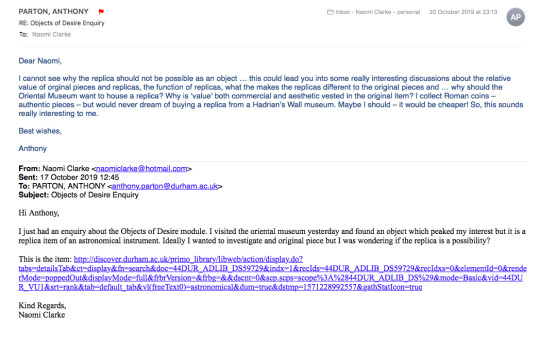
25/10/19
0 notes
Text
#4 - Meeting with Gillian Ramsay - 12/11/19 Replica Islamic Astrolabe Overall Description
I contacted Gillian Ramsay following our trip to the Oriental museum as she was the curator who originally purchased the replica astrolabe for the collection. We met in mid-November and she was very helpful in sharing her knowledge of the object and subject area.
She provided me with the Oriental Museum’s material on the specific object which informed me:
It is a replica Astrolabe created by ‘Hemisferium’, a specialist manufacturer in antique scientific instruments.
It is based on an original piece by Diya’al Din Muhammad created in 1647 in Lahore, (Now Pakistan).
The replica was made in Madrid, Spain around 2016/17.
The replica astrolabe is 180 mm (height) X 6mm (depth) X 120mm (width).
The astrolabe comes with a purpose-built wooden stand and is accompanied by two printed paper booklets explaining the history of the astrolabe, the parts of the astrolabe, and how to use it.
Both booklets are dual language, with one written in English and Spanish and the other in French and Italian.
The astrolabe is housed in a custom box made from red card with a black plastic insert moulded to fit the object.
On the lid of the box is an image of an elderly, bearded man, wearing a long, fur-edged robe and a crown, and holding a quadrant up to his eye.
Behind him stands a woman in a long dress and a turban decorated with a long feather and she is shown pointing up towards the sky.
The pair are shown in a rocky landscape with a river in the background and a crescent moon and stars in the sky.
Below the scene is the text 'Hemisferium instrumentos Cientificos Antiguos' printed in white.
0 notes
Text
#5 Interview with Gillian Ramsay

In the interview we touched the surface on some of the major areas regarded the Astrolabe which was incredibly useful as a base to know which areas to explore into further. I have outlined here what we discussed and will be expanding on them in later blog posts.
Purposes in the Durham Oriental Museum
Gillian informed me that they bought two of these replica Astrolabes from Hemisferium, one for their Islamic collection and the other for their learning team programme. The astrolabe is used to help teach children about early Islam as part of their school curriculum. She told me that it is one of the few places that can teach this topic in this manner as few people have the collection available.
The astrolabe piece is also used to teach about science and technology from Baghdad in the Medieval period – which was a centre for science, theology, philosophy amongst other things.
The pieces were bought for £69 each.
Gillian noted that authentic Astrolabes are a big gap in Oriental Museum collection as the original pieces are extremely expensive to buy and can go for up to £175,000 at auction. Gillian state this surge in attraction is partly due to collectors and curators previously opting for more conventionally beautiful pieces, like ceramics, but are now also considering objects of science or technology.
Diya 'al din Mohammad and his family
Gillian also illustrated the background of the original piece with me briefly. That it comes from a long line of scientific instrument manufacturers, spanning across four or so generations, who specialised in astrolabes & astronomical globes. They were specialists in their field, and even made objects for the Mughal court in India & Pakistan.
She noted that Mughal culture was a hybrid, sometimes referred to as ‘Indo-Persian’ as it was influenced from the traditional India valley but also had Mongal and Persian (early Iranian) influences.
She explained that Persia, which is now modern Iran and Iraq, was a centre for scientific development and scholarly academia, and the Mughal court was highly influenced by this – fostering the science and art the Persians initiated. They fostered miniature paintings, artists and carvers, and encourage scientists to come and set up in Major cities like Lahour.
Here like-minded people could mingle, discuss philosophy and science, and create things.
Astrolabe’s History
We further explored how Astrolabes began in Ancient Greece but that the technology essentially disappeared from mainland Europe with the coming of the Christians as they believed the technology was heathen and thus, set fire to the library in Alexandria and the main centres of study were essentially shut down.
She noted that the material then made its way into the Muslim world and Islamic scholars took up the knowledge that early philosophers & scientists had developed. Thus, Islam became the keepers of classical medical and astronomical texts, geometrical materials, and algorithms.
Islamic culture eventually spread to Southern Europe, in places like Sicily & areas like Moorish Spain, and the scientific texts and knowledge slowly returned to Europe and disseminated through the continent which influenced the Renaissance. Thus, Gillian pointed out that if we didn't have people in cities in Baghdad & Mughal Empire, we would not have had the Renaissance.
Development of the Astrolabe
Focusing back to the Astrolabe, Gillian indicated that it was one of the things that really developed during this height of the Islamic period. It started off as a basic item to measure specific astronomical constellations or the sun, as well as work out the altitude / height of the constellation from the horizon in order to work out the time of day and location.
In relation to the Muslim world, she noted that they were used to find the direction of Mecca, the qibla. It was further developed by adding detail which would tell you the fives times to pray each day.
Also that in the middle east most Mosques would have their own astrolabes - to help them find the right time to pray. Moreover, there would usually have been a Muwaqqit, somebody whose job it was to operate the Astrolabe in the mosque to identity the times of prayer who would then inform someone to give the prayer from the minaret.
When Astrolabes became popular in Europe again, they were used for navigation mainly but remained popular all the way through the medieval & renaissance period.
The Astrolabes were then developed into little portable versions for merchants travelling on the silk road, but also huge ones which have been turned into prestige pieces for important religious sites or in palaces.
When astrolabes made their way into Europe, after being in Southern Italy - European manufacturers start creating European astrolabes, often keeping the lines of prayer because it allowed them to work out when sunrise & sunset is - because that's two of the times that you have to pray in Islam, those are important for Christian prayer, so they just keep them. So there's little things that Muslims developed that then passed into European examples.
Other Collections
Gillian also noted other prominent collections in the UK including the Oxford museum who have other pieces from this family, and the British museum have a massive one in their Albukhary Foundation Gallery of the Islamic world. She noted that they would be good places to research into.
Image Credit: Oriental Museum
17/11/19
0 notes
Text
#6 Astrolabes Quotes
I have started to come across some nice quotes about Astrolabes so I thought I would use this post to store them all and update it as I go along.
عشق اسطرلاب اسرار خدا است cishq usturlāb isrār-i khudā ast Love is the astrolabe of the mysteries of God. — Jalāluddīn Rūmī (13th century)
यस्मिन् करामलकवद् वववदते वववदतं भवदे ् ववश्वम्॥ yasmin karāmalakavad vidite viditaṃ bhaved viśvam When you know the astrolabe well, you will know the universe like a fruit on the palm of your hand. — Rāmacandra Vājapeyin (1428)
A Mirror for Mathematiques, a Golden Gem for Geometricians, a Sure Safety for Saylors, and an ancient Antiquary for Astronomers and Astrologians. — Robert Tanner (1587)
Jalāluddīn Rūmī, the famous mystic poet, astrolabe is the sublime metaphor for measuring the immeasurable and for comprehending the incomprehensible. Thus he says: ishq usturlāb isrār-i khudā ast, ‘love is the astrolabe of the mysteries of God.
25/11/19
0 notes
Text
#7 Research Proposal
Objects of Desire Research Proposal
My object of desire is the Replica Islamic Astrolabe, accession number: DUROM.2017.323
Initial Description of Object
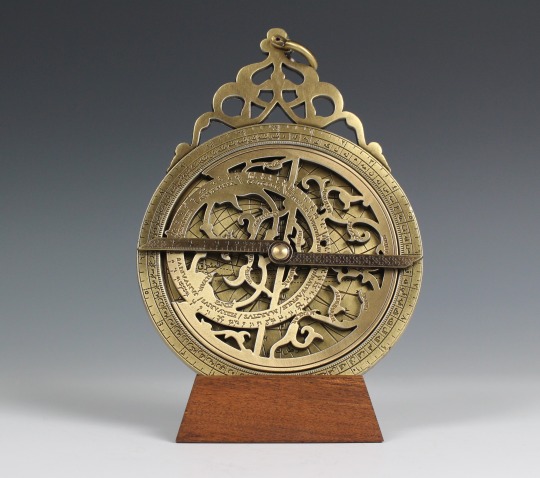
It is a replica Astrolabe created by ‘Hemisferium’, a specialist manufacturer in antique scientific instruments. It is based on an original piece by Diya’al Din Muhammad, who was part of a predominant family of astronomical instrument makers from Lahore.[1] The original piece was created in Lahore, Pakistan in 1647 whilst the replica was made in Madrid, Spain around 2016/17. The replica astrolabe is 180 mm (height) X 6mm (depth) X 120mm (width).
The astrolabe is an astronomical instrument made from cast metal which was originally used to measure angles, the altitude from the horizon to the celestial space, and for navigation purposes by helping to identify constellations to determine your location and the direction you were heading. Although, some Astrolabe specialists argue it has hundreds of uses.
Context
This concept was integrated into the Islamic faith when they inherited texts and technology from the Greeks, as they were going to be destroyed by the Christians who saw the technology as heathen. The navigational concept of astrolabes was adopted into the Islamic faith to help Muslims find the Qibla, the direction of Mecca, especially whilst they were travelling.
This piece isn’t simply a scientific instrument, but also a masterpiece of art and design with intricate carvings on the ‘rete’, the decorative netting overlay, which is designed with Arabic and Latin script and numbers which encapsulates the Greek and Islamic cultures its evolved from.
Rationale for Choice
I wanted to choose an object which stood out to me, or ‘spoke’ to me in a way. I have always had a fascination with celestial space – galaxies, nebulas, the solar system. One of my Art & Design A Level projects centred on this topic and I have always been curious of how outer space has been used for scientific purposes through the decades and in different cultures. As an English Literature student, I have not had the opportunity to learn about such scientific objects and their historical importance, and I thought this project would be a great opportunity to explore that intrigue. Equally, the Islamic culture and region of the Islamic Republic, where the original Astrolabe originates from, is an area I have not investigated in great depth and I feel this project will help open up a dominate area of worldly culture which is missing from my knowledge.
Contact with the Oriental Museum & Review of Existing Information:
I contacted Gillian Ramsay following our trip to the Oriental museum as she was the curator who originally purchased the replica astrolabe for the collection. We met in mid November and she was very helpful in sharing her knowledge of the object and subject area. She provided me with the museum’s material on the specific object which consisted of the dimensions, a brief description of the piece, details of its production, and materials used and how much it cost. As it is a replica it does not have a large paper trail of former owners or donors, but I believe it provides a unique opportunity to explore how and why it has remained an ‘object of desire’ for so many centuries and why are replicas still being produced.
The lack of direct material on the object I feel opens up a world of opportunity to explore the development of the astrolabe from its original concept in the Greek world and then to its use in the Islamic world. I also feel there is a great area for exploration amongst the original craftsman, Diya’al Din Muhammad, and his family and the seminal pieces they created that are still being replicated.
Research Questions:
I feel a central debate for my project is whether a replica can still hold the same value as an object of desire compared to an original piece?
Equally, whether the astrolabe has lost value when it is now being mostly used as an aesthetic piece rather than one of a functional purpose as a scientific instrument?
Questions surrounding the Astrolabe as a reference piece into the ancient Greek world, where it was first created, and whether it can shine light on to this culture and the importance they place on exploring the universe?
Exploration into how the Islamic culture utilised scientific objects to support their religion when Christian based religions rejected them.
Questions surrounding the evolution of pieces due to transferring cultures could be posed. The astrolabe was originally a scientific instrument developed by the Greeks and was adopted by the Islamic world who expanded its potential use through further scientific research. I feel it would be insightful to explore into this adoption of objects into other cultures and what implications does this have for the development of the object and the cultures?
Reflective Analysis
I think the first natural obstacle is that it is a replica, not an original piece. This means it does not have a personal story attached to it or a donor. I hope to counter this issue by contacting the replica manufacturer ‘Hemisferium’ to understand why they feel there is a demand for replicas of these pieces and to explore the questions of replica vs original and whether they hold equal value.
I hope to also explore the original manufacturing company from Lahore to see where the original piece is located and if it had an intended owner. Equally if the manufactures have any personal anecdotes and explore what their production line meant to their family as it remained as a generational business.
It is an intricate piece of science and I feel the first hurdle will be understanding how it works. I hope to consult scientific material and the Astrolabe specialist at the Oxford museum to understand how it actually functions.
Although, there is not a great deal of information on my specific item, there is an abundance of material on Astrolabes in general which makes the topic quite broad. I will tackle this challenge by being highly selective of what is explicitly relevant to my object of desire and the questions I want to answer, as outlined above.
Literature Review
Durham’s physical library came up short but their ‘discover’ link to online documents was highly fruitful.
- I have explored the general descriptions of Astrolabes and their evolution and purpose from: The Oxford History of Science Museum, The British Museum, The University of Hawaii’s, Institute for Astronomy, and the Smithsonian magazine, Oxford Art online.
Constanze Hampp & Stephan Schwan (2015) The Role of Authentic Objects in Museums of the History of Science and Technology: Findings from a visitor study, International Journal of Science Education, Part B, 5:2, 161-181.
Eagleton, C. (2019). What Were Portable Astronomical Instruments Used for in Late-Medieval England, and How Much Were They Actually Carried Around? In J. Nall, L. Taub, & F. Willmoth (Eds.), The Whipple Museum of the History of Science: Objects and Investigations, to Celebrate the 75th Anniversary of R. S. Whipple's Gift to the University of Cambridge (pp. 33-54). Cambridge: Cambridge University Press. doi:10.1017/9781108633628.003 https://www.cambridge.org/core/books/whipple-museum-of-the-history-of-science/72EAE4248EBCB8CA20DFFA3D1264557D
F., J. The Astrolabes of the World: based upon the Series of Instruments in the Lewis Evans Collection in the Old Ashmolean Museum at Oxford, with Notes on Astrolabes in the Collections of the British Museum, Science Museum, Sir J Findlay, Mr S V Hoffman, the Mensing Collection, and in other Public and Private Collections . Nature 131 https://www.nature.com/articles/131819a0#citeas
Falk, Seb. “Sacred Astronomy? Beyond the Stars on a Whipple Astrolabe.” The Whipple Museum of the History of Science: Objects and Investigations, to Celebrate the 75th Anniversary of R. S. Whipple's Gift to the University of Cambridge, edited by Joshua Nall et al., Cambridge University Press, Cambridge, 2019, pp. 11–32.
Hoskin, Michael, ‘Astronomy in the Middle Ages’, The History of Astronomy: A Very short introduction, Oxford University Press, 2003. https://www.veryshortintroductions.com/view/10.1093/actrade/9780192803061.001.0001/actrade-9780192803061-chapter-3
Huggins, M. L., ‘The astrolabe. II. History’, Popular Astronomy, Vol. 2, pp.261-266 http://articles.adsabs.harvard.edu//full/1895PA......2..261H/0000261.000.html
Jeffs, P. Science in culture: A culture of knowledge. Nature 439, 536 (2006) https://www-nature-com.ezphost.dur.ac.uk/articles/439536b
Latham, Marcia. “The Astrolabe.” The American Mathematical Monthly, vol. 24, no. 4, 1917, pp. 162–168. JSTOR, www.jstor.org/stable/2973089.
M.R. Brett‐Crowther (2010) ‘Science & Islam: A History’, International Journal of Environmental Studies, 67:1, 111-114. https://www.tandfonline.com/doi/pdf/10.1080/00207230903208407
Rodríguez-Arribas, Josefina, ‘Astrolabes in Medieval Encounters’, Medieval Encounters, September 2017, Vol.23(1-5) https://brill.com/view/journals/me/23/1-5/article-p1_1.xml?lang=en
Safiai, Mohd Hafiz, ‘Astrolabe As Portal To The Universe, Inventions Across Civilizations’, International Journal of Civil Engineering and Technology (IJCIET), Volume 8, Issue 11, November 2017, pp. 609–619 https://pdfs.semanticscholar.org/3f06/c9eab107851daaef4f5ac6c371c807fe94b4.pdf
Sarma, Sreeramula Rajeswara, “The Lahore Family Of Astrolabists And Their Ouvrage.” Proceedings of the Indian History Congress, vol. 55, 1994, pp. 287–302., www.jstor.org/stable/44143367. (To investigation into the original designer, Diya’al Din Muhammad, and his family is essential as they highly regarded astrolabe makers.)
Vafea, Flora. "From the Celestial Globe to the Astrolabe Transferring Celestial Motion onto the Plane of the Astrolabe". Medieval Encounters 23.1-5: 124-148. https://doi.org/10.1163/15700674-12342245
Ward, Rachel, “The Inscription on the Astrolabe by ʿAbd Al-Karim in the British Museum.” Muqarnas, vol. 21, 2004 - (To analyse how Astrolabes are depicted and investigated)
Further Sources:
Gillian Ramsay alerted me to the Oxford History of Science Museum collection. On investigation I found they have the ‘world’s largest collection of astrolabes’ and another astrolabe by Diya’al Din Muhammad. I also discovered that there is an incredible colossal astrolabe in the Albukhary Gallery in the British Museum. I have consulted both of their collections and online material, and I will be in contact with their curators for more in-depth questions I have on the topic such as: Why the curators feel such objects hold importance in the education of Islam and scientific development.
I also hope to visit both collections in Epiphany term if possible so I can compare their specific details to my Astrolabe as the designs, notably on the rete, are typically different on each which provides a personal and beautiful aesthetic quality to the object.
11/12/2019
0 notes
Text
#8 Basic breaking down of the Astrolabe: How each piece of the Astrolabe works
My astrolabe is made of cast metal and comprises of many intricate parts. As a scientific instrument, it is very complex and sophisticated. Each astrolabe is very unique in construction, design, and are set for different locations.
When we talk of astrolabes, we typically mean ‘planispheric astrolabes’. Sreeramula Rajeswara Sarma describes these as essentially a ‘representation of the three-dimensional celestial sphere on a two-dimensional plane by stereographic projection’.
He notes ‘the most common type is the northern astrolabe’ which projects the North Pole as the centre of the astrolabe and the outermost periphery is formed by the Tropic of Capricorn. So it is aligned only for stars which are north of the Tropic of Capricorn. You can also get Southern Astrolabes which reverse the situation and the centre is formed by the celestial South Pole and the outer periphery by the Tropic of Cancer, and it represents stars whose courses are between the south pole and the course of the beginning of Cancer. A few were made as North-South astrolabes so they could display stars on both hemispheres.
The British Museum blog depicts astrolabes as ‘complex devices which use several moving parts to turn raw data provided by the user into practical information’. In many ways, they are seen as ‘the computers of their time, used to solve problems relating to the position of the sun, stars, planets and timekeeping.’
I have done some research into what each part of my astrolabe actually is and how they work, and I will try to convey this information.
Moreover, I will be contacting Hemisferium for assistance in breaking down the exact intricacies of my astrolabe.
Astrolabe Summary:
The astrolabe is usually made of brass or copper, circular in shape, and can vary from a small handheld piece, to large ornamental works.
The front of the astrolabe comprises of a face or mater, which holds plates or tympanum a throne attached to the top of the mater and a decorated rete or net covering the mater. Modern adaptations also have a Regula. The back is divided into an upper half and lower half and it has an alidade.
Front

Body/womb or Mater (Arabic: umm/ أم)
The mater or body houses the plates or ‘tympani’, and the net or ‘rete’.
The mater is a body which is deep enough to contain several plates.
The face was often engraved with circles around the rim or limbus which could be broken down for the twenty-four hours of the day, the zodiac calendar etc. As well as engraved lines for the tropic of cancer and Capricorn, and the equator.
Plate or tympanum (Arabic: safiha)
Each plate or tympanum is inscribed with a projection of sky above an observer at a given latitude.
Each plate is calculated for a different latitude so they can be used in different locations. One places on top the plate one wishes to employ.
Often engraved on the plate are names of cities, their longitudes, latitudes and identification.
Rete or Net (Arabic: ankabut / شبكة)
On the surface of the mater sits the rete or net, it is the map of the stars as it is engraved with star constellations and the ecliptic (the path of the sun against the background stars).
The constellations through which the sun passes on the ecliptic are the signs of the Zodiac.
The spikes on the rete indicate the positions of individual stars.
It can be rotated so it reflects what the user sees in the sky.
It is also very decorative. Some have vines, intricate patterns, animal heads, and zodiac signs cut into them.
Regula or ruler
A rotating ruler which offers agile, precise and versatile solutions to many problems (some of which cannot be solved without it).
Throne (Arabic: Kursi/ كرسي)
The mater is topped with a triangular shaped ‘throne’ rising to a trifoil shaped point.
Attached to the thone is a Ring/Halqa/ حلقة which allows the astrolabe to be held flat at eye-level.
Back of the Mater (Arabic: zahr/ زهر)

The face is usually engraved with several circles divided by different kinds of gradations, such as 360 degrees, or 365 1/4 parts for the days, 12 for the months, etc. This data would then be used to make calculations to help serve the task at hand.
The back of the instruments is divided into an upper half and lower half, and oftentimes into four quadrants.
Each section contains various trigonometric scales and astrological tables.
Alidade or Label (Arabic: Al-‘idada / الحلقة العضدية)
A rotating bar which is used to measure angles, determine directions and look at constellations.
This side of the instrument is divided into degrees for taking altitude measurements, and is also engraved with a calendar and divisions of the zodiac.
It has sighting vanes, the observational part of the astrolabe, which allows the user to establish the altitude of the Sun and the stars to help work out direction and time.
For example, you set the latitude and longitude and then look towards the constellation and where it aligns on the marked degrees can help determine your direction and time.
In Islamic astrolabes – There were often also ‘prayer lines’ which were used to indicate the correct times for Muslim prayers in different seasons.
Pin (Arabic: Faras / فرس)
Most Arabic astrolabes have a bolt performing as axis traverses the alidade, the mater, the tympanum and the rete.
Image kindly provided by Durham Oriental Museum.
28/12/2019
0 notes
Text
#9 How to use the Astrolabe
Basic description of how to use an Astrolabe by a British Museum Albukhary Curator

I wanted to learn how to use such an instrument, so I watched many videos on the internet of astronomers and curators explaining the process. I found the description by British Museum Albukhary Curator, William Greenwood quite succinct and ease to follow. The link to the video: https://www.youtube.com/watch?v=N8oWGwcdFmA&vl=en-GB
A basic summary of his depiction on how to use an astrolabe is as follow.
- First you must let it hang straight and align the Alidade with the sun or a prominent star until the rays shine through both sights, this helps measure the altitude of this point.
- You would then use the engravings on the back of the mater to help point to a particular date and time.
- Next you would rotate to the front of the mater, adjust the rete according to this values, which will tell you more details, such as what time it is or what direction you are in.
- You can also do this in reverse when you know a stars location by aligning the front of the mater, and then flipping to the back of the mater to provide you with more information.
Uses of the Astrolabe
The astrolabe can be used for an abundance of purposes. Range from scientific, religious, geographical etc.
One astronomer of the tenth century even argued it had thousands of possible applications.
Some of the common uses are:
To establish the time using the Sun’s height/altitude or azimuth
Using a star’s height to determine the time at night
Establish the sunset, sunrise and twilight time
Work out the position of a celestial object
The declination and ascension of any planet, comet, or star
Work out the length of the day
The time it is when a certain star rises
For direction by working out the Sun’s azimuth or a star’s azimuth if we know their height
To determine the height of an object or building
Determining the time for Muslim prayers
Times for crops to be planted
Rising and falling of tides
Limitations of the Astrolabe
The illustration of each component and basic description of how to use it indicates how intricate and scientific this object is, and thus, you have to be quite well educated on the topic to use it properly.
This has been a similar limitation throughout its history. The user had to be literate, as it is covered in writing, have the technological knowledge to operate it, and further mathematical knowledge to read and use it correctly. They could also be used in collaboration with other objects, like an astronomical globe or sundials.
This meant that it was mainly used by a merchant or elite class of individuals. This class were usually the ones who travelled anyways, and it was useful for their navigation.
Some other high-class individuals and royalty collected them as elite prestige objects, they were occasionally from gold to enhance their value.
Image Credit: British Museum
17/01/2020
0 notes
Text
#10 The Astrolabe being used within different fields
Curator William Greenwood also breaks down how astronomy and astrology was considered within science for most of its existence.
That astronomy was looking at the skies and trying to understand natural phenomenon.
Whilst Astrology is what those stars, planets and phenomenon are supposed to do upon on earth. He noted that, although astrology is generally seen as less scientific today, that for the longest time up till very recently, astrology was seen as much of or maybe even more of a science than astronomy. Astronomy was there to serve astrology.
Roderick and Marjorie Webster break down some of these uses in Western Astrolabes
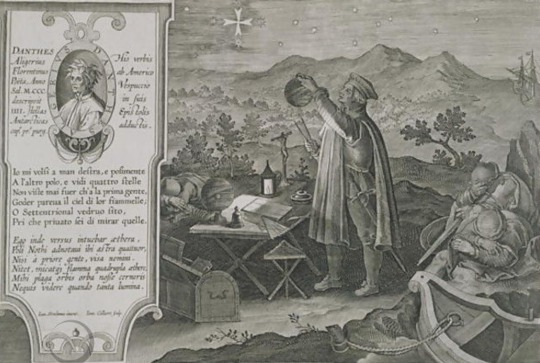
Astrologers
The Webster’s point out previously that astrologers would use scientific instruments like astrolabes to practice ‘natural astrology’ for ‘foretelling the weather, earthquakes, diseases, mortality, wars, discords, and conspiracies from the state of physical conditions, which were thought to be dependent both on the course of the planets through the signs and on the appearance of comets. ‘
They note alternatively they also practiced ‘judicial astrology’ which ‘attempted to divine the outcome of human affairs from the disposition of the heavens at the time of a client's birth or the occasion of an election.’
The Webster’s outline how astrological readings would work with astrolabes, that ‘judicial astrologers answered horary questions. In other words, they would be consulted by a person preparing to undertake a great project or go on a business trip. Once the astrologer learned the time of the client's birth, he saw how that person's horoscope corresponded with the aspect of the celestial bodies at the time the inquiry was made. Upon this comparison, he foretold how successful the undertaking would be-typically adding that God may do more or less as he pleased.’
Medicine The Webster’s further illustrate how astrology was also a ‘major component of medical care’. That since the Middle Ages, ‘astrolabes were used to determine the critical days of an illness, the optimum times for bleeding, and occasions for medications.’
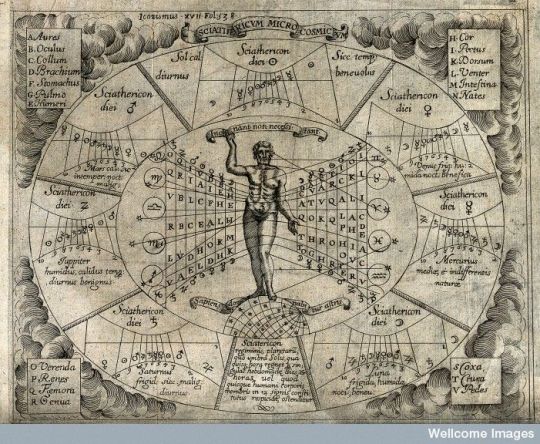
Dark Arts
The Webster’s further note that ‘Western sources confirm that astrolabes were used in the darker, prophetic arts.’
That a ‘medieval manuscript of Czech origin shows astronomers toiling with astrolabes alongside geomancers.’
They reference that there is even ‘crude woodcuts in chapbooks’ which depict ‘astrolabes alongside Dr. Faustus, seen conjuring in a circle, with the devil beside him.’
Geography
Geography, navigation, and surveying – which might be grouped together as topographical arts – were other institutions which used astrolabes.
Any astrolabe could be used to find the difference in longitude between two towns if the initial time of a lunar eclipse was noted each location.
Used at sea
The Webster’s further remark that in astrolabe ‘early use at sea would have been difficult, given the rocking of the ship and the wind resistance offered by the metal plate’. However, they note that ‘these problems were overcome in the late fifteenth century, when the instrument was stripped of all nonessential parts, leaving only a heavily weighted, graditated limb and an alidade.’
Thus, in this new form, ‘the astrolabe came of age as a nautical tool and it was readily adopted by Renaissance sailors, who were taught to sail by the altitude of the pole star or "run down the latitude.”’
Image Credits: [email protected] and WelcomeImages
18/01/2020
0 notes
Text
#11 Contacting Hemisferium
I contacted Hemisferium’, the specialist manufacturer in antique scientific instruments who made my replica object, as I wanted to learn more about their process, ethos, and purpose for making replications of scientific instruments.
I tracked down their email address and composed an email introducing myself and asked if they would be willing to answer a few questions.
I was very impressed at how quickly they got back to me and how helpful they were. A lovely lady called Adriana Benshimol replied and was very keen to help.
She was able to break down for me the replication process, the evolution of the replica item from the original piece, and their aims and purpose of their replication company.
The following posts will break down this information.
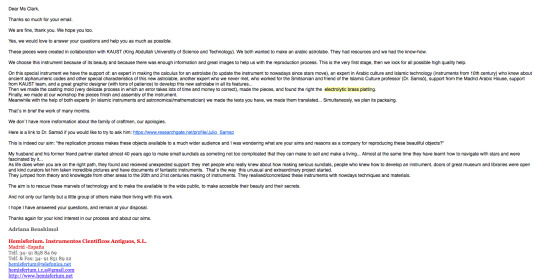
01/02/2020
0 notes
Text
#12 Breakdown of Diya’Al Din’s original astrolabe
After contacting Hemisferium I was surprised to learn that my object was not an exact replica of the original piece made by Diya’Al Din Muhammad in 1647, but that it had involved an extensive team who worked on analysing the original and then updating it for the contemporary day.

Object title: Astrolabe: Eastern
Maker(s): Diya' al-Din Muhammad (Maker)
Date produced: 1647 - 1648
Place of production: Lahore, Pakistan
Material(s): Brass, Copper
Dimensions (H x W x L): 21.1 (cm) x 12.3 (cm) x 4.1 (cm) (Object)
Dimension notes: Mater thickness: 0.9 cm
Description: Body, rete, graduated diopter with scales and sights, pin, handle, ring and 4 tympans. Horse missing. 33 star markers. Labelled in Arabic.
Inscription/signature: `amal diya' al-din muhammad ibn mulla qa'im muhammad ibn mulla `isa ibn mulla allahdad asturlabi humayuni lahawari sanah 1057 hijri" [The work of Diya' al-Din Muhammad ibn Mulla Qa'im Muhammad ibn Mulla `Isa ibn Mulla Allāhdād, the astrolabe-maker, the Humayuni, the resident of Lahore, in the year 1057 of the Hijra].
On display: Astronomy in Culture
Hemisferium were able to provide me with a breakdown of how exactly the original 1647 Diya’Al Din Muhammad astrolabe is composed which is as follows:
Front
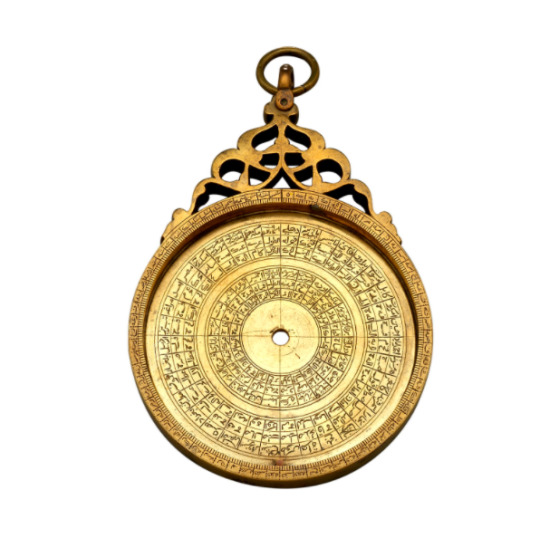
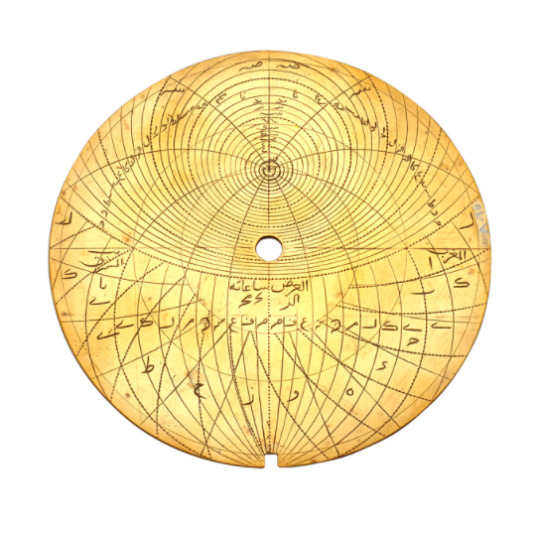
Engraved on the original mater are two concentric circles, bearing names of cities, their longitudes, latitudes and identification.
The inner circle includes two cities referenced on the back of the instrument: Lahore, longitude 109° and latitude 31.5°, and Varanasi, longitude 117.2° and latitude 26.5°
On the periphery we find the limbus, or outer rim, labelled with 1 degree marks and 5° intervals which run clockwise from 1° to 360°, with the latter located under the throne.
This original piece includes four different plates for different latitudes, plus two others, one of them with multiple horizons and the other for the 66.5° latitude, which enables the user to convert from equatorial coordinates to ecliptic ones.
In the lower part of each plate there is a notch that fits onto a pin in the lower part of the mater, so that the plate is properly fixed and there are no displacements.
On the plates or tympani, circles denoting heights (almucantars or almucantarats) are indicated every 3° and azimuths every 30°.
Uneven hours and Babylonian hours are also represented.
The rete or net, which is on the surface of the mater, portrays the ecliptic, which is subdivided every 6, 12, 18, 24 and 30 degrees, starting from each sign of the zodiac. Stars are noted on a separate list, thirty-three in total.
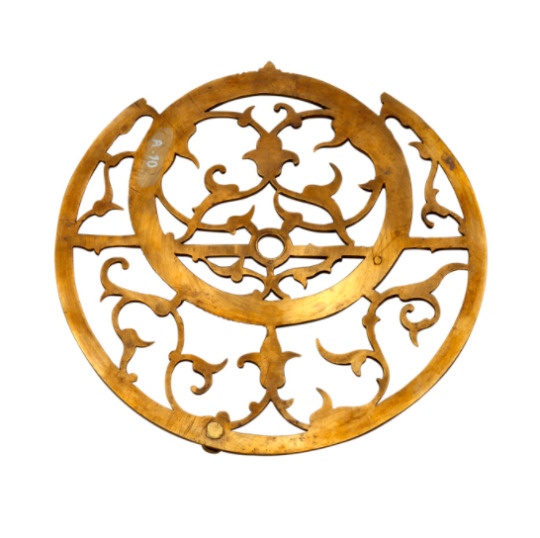
Back
The back of the instruments is divided into upper half and lower half.
Upper half of the back
On the outer rim of the semicircle, the upper half contains two scales for measuring heights, labelled degree by degree (following the alphanumeric system) and with divisions at every 5° up to 90°, starting from the horizontal on both right and left.
Each scale originates at 0° and ends at 90° in the central section of the throne, in such a way that the left-hand side scale progresses clockwise, and the right-hand side scale goes anti-clockwise.
On the left-hand side of this semicircle there is a Sine scale divided into thirty equal double parts.
On the right-hand side there is a scale of maximum heights, which represents the curves for latitudes – 27° (Varanasi) and 32° (Lahore).
This scale for maximum heights includes distances for the entrance into the signs of the Zodiac (separated by equal distances).
There are ‘prayer lines’ with the purpose of indicating the correct times for Muslim prayers in the different seasons.
In most Islamic astrolabes, a quadrant on the back (quarter of the circle) depicts a chart corresponding to the Sun’s altitude at the moment it crosses the zenith in Mecca for a particular latitude. This way, if we determine the altitude corresponding approximately to a particular day of the year, we will see the Sun is located at the altitude we have determined on the chart. The Sun’s azimuth at that moment will correspond to the azimuth of the Qibla.

Lower half of the back
The lower half has an engraved ‘shadow quadrant’ which is an altitude scale.
On the right, both the straight shadow scale (umbra recta) and the reverse shadow scale (umbra versa) are divided into 12 inches.
On the left, they are divided into seven feet.
Inside this square are engraved the names of the signs of the Zodiac and, further inside, the Lunar Mansions.
On the rim of the lower half, surrounding the shadow quadrant, there is a cotangent scale.
The right-hand side is divided into 36 parts and the left-hand side into 21 parts.
Alidade
The alidade has sights/vanes which allow the user to establish the altitude of the Sun and the stars.
It is furnished with a scale for maximum heights and another scale for the Sine measures.
This astrolabe does not have the typical bolt which traverses the alidade, the mater, the tympanum and the rete.
Although it has an indentation which matches the wedges of the other components and allows the user to rotate the alidade and the rete over the plates
Throne or Kursi
At the top of the back, there is a detailed throne with a hole designed for the hanger rings. (So the user could hold the Astrolabe easily).
In the centre of the back is the name of Diya' al-Din Muhammad, that he was the son of Qa'im Muhammad, and that is was produced in Lahore in 1647-48.
What is Notably missing
Hemisferium noted an important shortcoming in the original astrolabe is that there is no regula, and the hours are not inscribed on the limbus in two XII-hour halves; there is no zodiacal calendar either.
All images kindly supplied by the Adler Planetarium
10/02/2020
1 note
·
View note
Text
#13 The process in updating Diya’Al Din Astrolabe to Hemisferium’s replica piece

Adriana from Hemisferium kindly explained how the collaboration project worked to create their Astrolabe.
The Astrolabe was created in collaboration with Hemisferium and KAUST (King Abdullah Universtity of Science and Technology). She explained Hemisferium had the resources and KAUST had the know-how, so it was a perfect partnership.
They chose Diya’Al Din Muhammad’s 1647 piece for its beauty and that there was enough information and clear images available to help with the reproduction process.
They also then brought on board a whole team of specialists to aid the project. They included:
Dr Luis Hidalgo, an expert in making the calculus for the astrolabe so they could update the instrument for the contemporary day since stars move. He also made all the calculus which is in the booklet which accompanies their astrolabe.
Dr. Julio Samsó An expert in Arabic culture and Islamic technology and scientific instruments from 10th century who knew about ancient alphanumeric codes and other special characteristics for this new astrolabe.
An expert who works for the Smithsonian Institute and friend of the Islamic Culture professor Dr. Samsó.
Additionally support from the Madrid Arabic House, and the KAUST team.
As well as a great graphic designer, who has a lot of patience, to develop this new astrolabe in all its features.
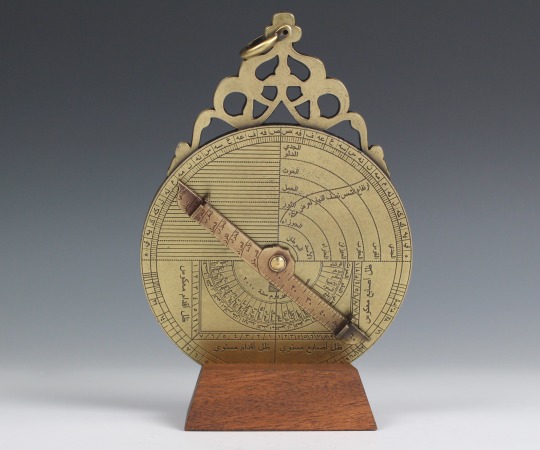
The reproduction process involved:
Making a casting mould which Hemisferium noted is a very delicate process in which an error takes lots of time and money to correct.
They then make each piece, find the right electrolytic brass platting to meld it together.
Finally, in their workshop the instrument is assembled and finished.
The accompanying text are made with the help of both experts (in Islamic instruments and astronomical/mathematician) and then they are translated.
It amazed me how intricate and thought-out the reproduction process is. The labour, time, and expertise which goes into this project, to not only replicate the item but to redevelop it for the contemporary day, I find incredible. This has opened my eyes to a whole new side to my astrolabe as I feel it has acquired an even richer history now.
Updates to modernise the replica Astrolabe
This process of modernising the astrolabe reads to me as the Hemisferium carrying on the long tradition of scientific instruments and knowledge being passed between generations and cultures and acquiring updates and new elements to complement the society and its needs.
These practices worked through learning off previous makers and developing it for your own process and Hemisferium are simply continuing on this legacy.
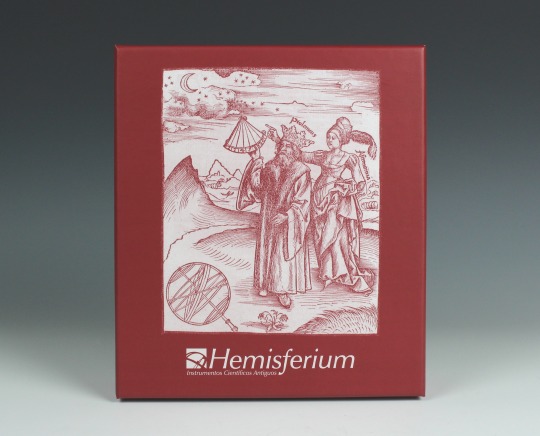
11/02/2020
0 notes
Text
#14 Contacting Dr Julio Samsó – Involved in the Reproduction of the Astrolabe – Depicting the updates to modernise the replica Astrolabe
Adriana from Hemisferium kindly passed on a link to Dr Julio Samsó’s profile on researchgate. He was the expert on Arabic culture and Islamic technology and scientific instruments who helped compute the ancient alphanumeric codes and other special characteristics for this new astrolabe.
I contacted him through researchgate.net but unfortunately I did not receive a reply. However, this did not deter me, and I searched for any information on him on the internet and I was able to track down his University email as he is a Professor at the University of Barcelona.
Very unexpectedly I received an email back a few days later!
I wanted to pose a few questions to him. First and foremost, the replication process and what had been the major updates.
He pointed me in the direction of the booklet which comes with my astrolabe which he helped to write. Thankfully, I managed to get a copy of this from Adriana which was incredibly useful. As well as illustrating some other points of development.
He informed me that ‘it was never their aim to make an exact replica but to build a similar piece in the Oriental style for the latitude 21° 32’ N.
It was meant to be as ‘faithful as possible to the original but, at the same time, updated and furnished with certain essential elements that make it useful in present times.’
From a combination from his booklet and email I have illustrated the main updates:
The front of the Hemisferium astrolabe
Regula
Hemisferium updated their model to contain the classical regula (ruler), which offers agile, precise and versatile solutions to many problems (some of which cannot be solved without it).
The updated regula also offers the great advantage of saving the user tedious and repetitive movements, as well as the mathematical calculations needed to establish the time in degrees and then convert the latter to hours and its fractions to minutes. These operations were originally all performed with abacuses.
Limbus
Updated in line with the traditional ‘European’ style of astrolabes, the limbus was divided in two XI- hour sections, AM and PM, and each section is divided into 15 and 30 minute sections.
Calendars
The ecliptic was altered to include a monthly and daily Gregorian calendar.
Zodiac Calendar – There are also entrances for the different zodiacal signs marked with the corresponding symbol. The entrance for each sign also corresponds to dates on the Gregorian calendar, for example, the entrance into Aries corresponds to the 21st of March and entrance into Libra to the 23rd of September.
Intervals are placed every 5 days in order not to alter the back of the astrolabe.
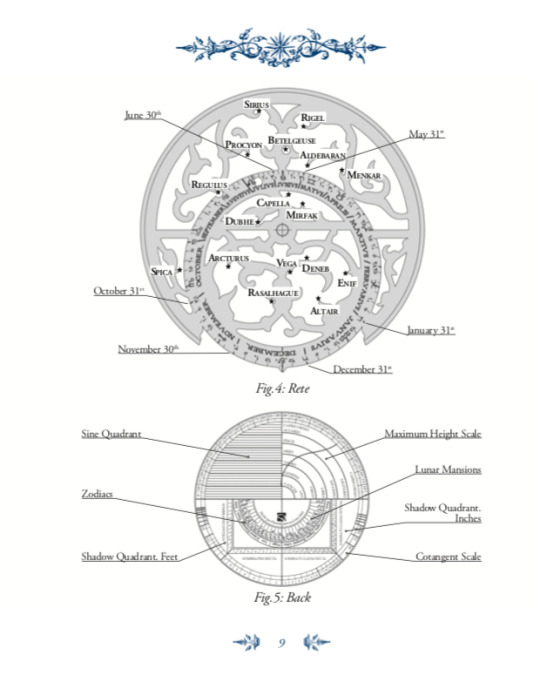
Rete or net (Fig. 4)
It has been abridged and updated by reducing the number of stars and leaving only the most relevant ones, with a cleaner plate in mind.
The stars placement also had to be updated to their corresponding locations for the 21st Century as stars change position so they are not where they were when the original piece was made in 1647 in terms of their Right Ascension and Declination.
They were able to accurately correct this through logic and calculations. They took the knowledge that the precession of the equinoxes is equivalent to 50’ of the annual arc and that 71.5 years correspond to 1 degree. Thus, with this update they could update the pattern without fear of any imprecision.
Plates to Mater
Diyâ' al-Din's astrolabe included 4 plates engraved on both sides, as well as an astrological plate engraved in the mater, whilst the replica does not have plates.
On the replica, the mater has the diagram of the Equator, tropics of Cancer and Capricorn, horizon, circles parallel to the horizon, and vertical circles.
They are set to a latitude 21º 32' which corresponds to Jidda in Saudi Arabia. (Fig. 1)
Dr Samsó informed me that Hemisferium had planned to sell the instrument in Saudi Arabia which explains the choice of Jidda and Mecca.
The almucantars (heights) are labelled every 10° and azimuths marked every 10° and highlighted every 30°, increasing from the South.
This gradation is represented by a ciphered alphanumeric type scale, following the use of the period.
It also has a crepuscular (twilight) line corresponding to astronomic sunset (when the Sun has a negative altitude of -18°).
They also included the temporary and Babylonian hours for that latitude. (Babylonian hours were equinoctial or equal hours which represented the time elapsed from sunrise and were marked by the Sun’s nadir or antisolar point under the horizon; they were numbered from 1h to 13h.)
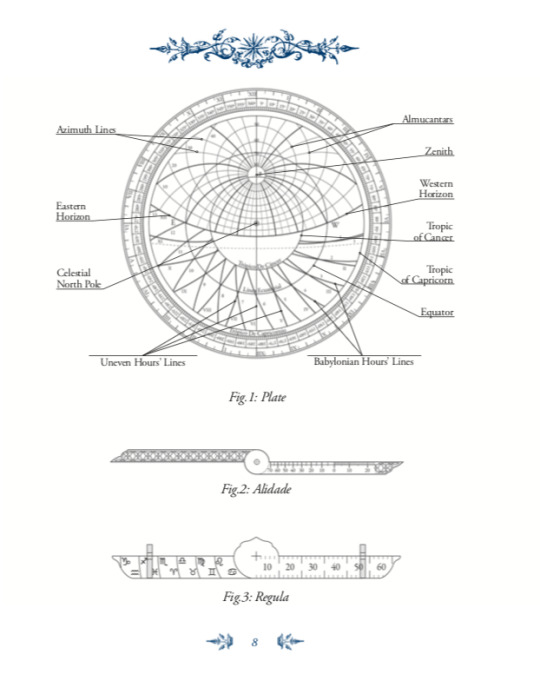
Back of the Hemisferium astrolabe
The back (Fig. 5) of the instrument has been almost preserved completely.
Alidade
Only the alidade has been changed, for one belonging to another astrolabe made a few years later (1660, catalogued as A-81) by Diya’al Din Muhammad in Lahore.
This alidade is more in keeping with the drawing of the scales in our piece.
Curve of the solar meridian
The replica also contains the curve of the solar meridian altitudes throughout the solar year for the latitude of Mecca (modern value 21º 26').
In Diya' al-Dîn's astrolabe there were two curves for latitudes 27º and 32º
This scale is made up of distances for the respective entrances into the signs of the Zodiac (separated by equal distances).
Diagrams by Hemisferium
20/02/2020
0 notes
Text
#15 How to Establish the time using Hemisferium Astrolabe
Hemisferium’s booklet breaks down how to use their astrolabe for these different purposes. This is their detailed breakdown of how to use their astrolabe to establish the time using the sun’s height.
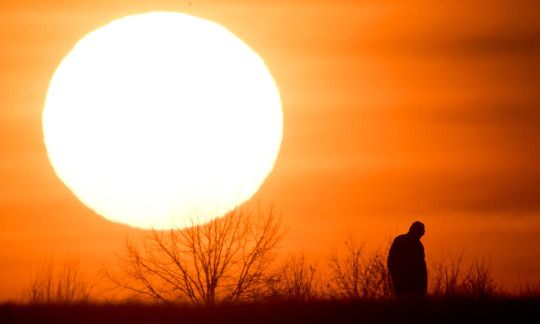
Establishing the time using the Sun’s height
They take May 21st as the date for their example.
On this day, you calculate the height of the Sun in the afternoon with the help of the alidade, placing it in such a way that a ray of sunlight comes through the first vane and falls on the centre of the second vane, which should produce 20°. (They warn that one should never look at the Sun directly through the vanes, since there is risk of going blind.)
Next, you must locate on the ecliptic the solar point corresponding to May 21st, which is exactly 0° Gemini ( ).
Next, you rotate the rete or net until the solar point falls over the South meridian (a circle of constant longitude passing through a given place) which is under 360°.
You then read the number of degrees marked by the net’s index and copy down this number. In this case the number should be 150°.
After this you must rotate the net/rete until the solar point coincides with the almucantar (circle on the celestial sphere parallel to the horizon) corresponding to 20° on the right-hand side of the astrolabe.
The net’s index should now indicate 227°.
Therefore, the hourly angle of the Sun will be 227°-150°=77°.
This will then be divided by the 15° that correspond to each hour, with a result of 5,13h.
This can then be converted into hourly fraction to minutes: 5h8m, which, when added to XII hours, give us a final result of 17h8m (local solar time).
This is the method for establishing the time in Arabic astrolabes that do not have a regula.
If you employ the newly incorporated regula, you simply have to displace the ecliptic’s solar point to almucantar 20°.
Image Credit: Linda Geddes via Aeon
20/02/2020
0 notes
Text
#16 History of the Astrolabe from the Roman Empire to the Renaissance
As astrolabes, and scientific instruments for astrological purpose in general, are something I am not familiar with, I wanted to research into the history to understand the origins and development of these objects throughout the centuries. This is what I have garnered from my research.
Greek Origin
The name astrolabe comes from the Greek astro, which means ‘star’, and labio, ‘one who seeks or catches’, therefore ‘star seeker’ or ‘star catcher’ is a common translation.
The first concepts of the astrolabe date back to 150 B.C. in the Hellenistic period. These ‘star seekers’ are believed to have begun as ‘flat planispheres’, rotating star charts, which offered solutions to problems in regard to the rise and set times of the sun, as well as when the horizon would be in specific locations.
It is considered the Greek Claudius Ptolemy in 140 A.D. developed the ‘Astrolabon Organon’, an observational instrument which was similar to the early ‘star seeker’, or ‘armillary sphere’. This new development allowed the user to determine ecliptic, equatorial and horizontal coordinates.
Ptolemy also wrote Planisferio, which Hemisferium cites as the first text to explain ‘stereographic projection – a much older theory on which the development of the planispheric astrolabe was based.’ Ptolemy’s planisphere performed the functions of a star-finder, but it appears not to have been used for directly measuring the altitudes of stars.

The instrument we have come to know as the astrolabe – complete with rete, tympans, and alidade – was invented sometime before the late fourth century, when Theon of Alexandria wrote a tract on it. Hemisferium note other early important texts by John Philoponus (530 A.D.), from the school of Alexandria, and Severus Sebojt (650 A.D.).
Image Credit: Greek Claudius Ptolemy via researchgate.net
27/02/2020
0 notes
Text
#17 Movement to Islamic Culture
After the fall of the Western Roman Empire, countless amounts of knowledge were lost, symbolised in the great library burnings of Alexandria. However, the eastern part of the empire, what would become the Byzantine Empire, continued to flourish due to Islamic scholars preserving and building on their science and philosophy from around the seventh century AD onwards. Without them humanity would have lost even more of the advances of antiquity.
Roderick and Marjorie Webster note that ‘prior to the tenth century, knowledge spread eastward from the Syro-Egyptian region through Harrãn to Iraq and Persia. In the Mashriq (the East), the astrolabe-making craft was highly esteemed during the reigns of the first ‘Abbāsid Caliphs, and that of al-Ma’mūm (787-828) in particular.
However, Islamic culture did not just inherit the knowledge and translate it, but P. Jeffs remarks that ‘Arabs of the expanding empire transformed and extended Greek, Mesopotamian, Persian and Indian ideas, and turned theory into practice.’
In this application they ‘produced exquisite manuscripts, developed experimental sciences, and added new disciplines to those of the classical world’
This development of knowledge was transmitted through scholars travelling and captured through the newly-founded paper production industry. Jeffs states that ‘almost 4 million individual Arabic writings from the eighth century onwards are known to have been conserved by libraries throughout the world.’
Importance of Education / Knowledge in Islam

Science and education thrived within Islamic culture as it is highly revered within the Qur’an, Islam’s Holy Book. The Hemisferium booklet notes that the term ‘Ilm’ is ‘knowledge, wisdom or science and is held second in prominence only to Allah.’
Thus, the Qur’an ‘encourages reading and study, both of nature and of the Qur’an itself.’ It is believed that knowledge from human reasoning is complementary to knowledge from the Qur’an as both are ‘signs from God’.
This manifested in the upsurge of development in science, including: mathematics, algebra, trigonometry, astronomy, medicine, architecture within Muslim cities.
The great scientists and thinkers of this period built on the great minds before them from Greek, Indian, Babylonian and pre-Islamic sources.
Hemisferium remarks that this was particularly prominent during the so called ‘Golden Age of Islam’, when these cities flourished as centres of art and wisdom.

The development of the Astrolabe in Islamic Culture
Sreeramula Rajeswara Sarma argues that ‘the production of precision instruments can be said to originate in the manufacture of astrolabes in the Islamic world.’ Thus, the Islamic world developed the Hellenistic theory into practice and today the astrolabe is considered as the most sophisticated and elegant astronomical instrument before the birth of the telescope.
Oliver Hoare, one of the most influential Islamic art dealers, has observed that ‘the ability of Islamic civilization to perfect what it inherited, and to endow what it made with beauty, is nowhere better expressed than in the astrolabe.’
Within Islamic culture in the ninth century, Muslim astronomers developed the device by adding in angular scales and azimuth lines, which improved its function and beauty.
The astrolabe was developed so that it became a combination of a rudimentary observation tool and an elegant analogical computer. The device was used for multiple tasks from estimating time and measuring heights –both of celestial bodies and geographical accidents– to drawing horoscopes.
It also developed further purpose in Islamic culture as further markings were added to the plates which mark the five times of prayer so that it can used to help Muslims know when to pray each day. As well as the instrument was adapted to help locate the direction of Mecca (qibla) so they could pray in the right direction no matter where they were in the world.
Within the Islamic world, being able to adept in the use of an astrolabe or celestial globe was the manner to describe a good astronomer. Sarma further notes that Astrolabe making became an important profession in the ninth century, it indicated a high professional status because the construction involved not just skill in metal-craft but also sound knowledge of astronomy and trigonometry.
The earliest dated Astrolabe which is still extant is believed to be by Muḥammad ibn ʿAbd Allāh Nasṭūlus. There are four known astrolabes by him in world, one which is dated in 315 AH (AD 926-27) and is preserved in the Islamic Archaeological Museum, Kuwait.
Images: Electa / Mondadori Portfolio / Getty Images; Cover of ‘The Persians’ by Aeschylus
27/02/2020
0 notes